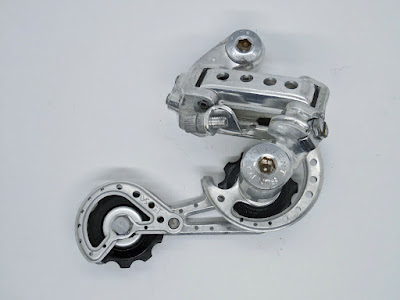It's also not the only element ending in '-ium": lithium, sodium and potassium are among the best-known. One thing I learned from working in bike shops, though, is that you shouldn't get all of your education, even in the sciences, from school. Indeed, in those velocipedic variora, I found out there were other elements besides molybdenum and titanium. Like "can't-affordium", that mythical material used to make bikes for those who spend more dollars than miles (or even kilometers) on their machines. And then there was that material that developed holes whenever it was made into bicycle parts. I am referring, of course, to drillium.
Now, some drillium bits were stylish and, on occasion, even made sense. Drilling brake levers often improved their grippability: That, I think, is one reason why Campagnolo and other companies actually made lever blades with holes or slots built into them. Interestingly, the slotted Campy Record brake levers actually weighed a few grams more than the plain ones. Someone from Campagnolo explained that the material was actually slightly thicker so that strength wouldn't be compromised.
While drilling didn't serve any purpose, other than minute weight reduction, on chainrings, I think those are the components that looked best when touched by drill bits. Some derailleurs also looked good with it, though on some components--like the Huret Jubilee--drilling was impossible and, really, pointless because they were so light.
Believe it or not, there were also drillium saddles. I was reminded of them when I came across this photo:
I wonder whether Monsieur Herse punched the holes in that seat. Or was it made that way? Back in the '80s, Tioga--the maker of some of the best parts and accessories found on early mountain bikes--offered a seat for BMX that wasn't what most of us would think of as "drillium", but was in the spirit of it. The "Spyder" seat was very popular on the BMX circuit--and, interestingly, is still made today:
From what I've heard, some cyclists--time trialists, mainly--even took took off the covers and padding of Cinelli Unicanitor seats and drilled out the plastic base. Of course, most people never saw their handiwork, at least if the padding and leather cover were glued back on. But a few such cyclists took the plain plastic-shell model (without the padding and cover) and drilled that out. Hmm...I wonder what it was like to sit on such a thing with unpadded shorts!
I imagine that not even those Unicanitors survived the treatment for very long, which may be the reason why we don't see very many "drillium" or "spyder" seats today!
Is the symbol for "drillium" "Dr"? Or just "D"? As I said earlier, it's been a while since I took chemistry!
































